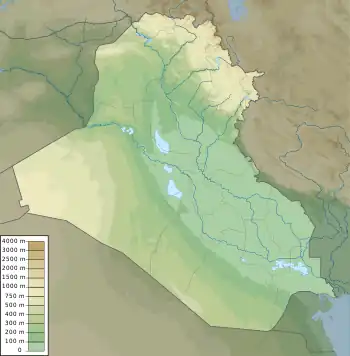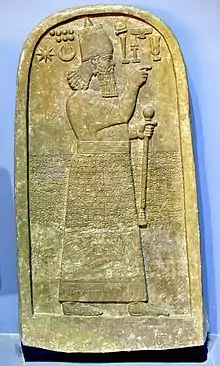Tell al-Rimah
Tell al-Rimah (also Tell al Suppan) is a tell, or archaeological settlement mound, in Nineveh Province (Iraq) roughly 80 kilometres (50 mi) west of Mosul and ancient Nineveh in the Sinjar region. It lies 15 kilometers south of the site of Tal Afar. Its ancient name may have been either Karana or Qattara, though the later name is now less favored.
Qattara/Karana (?) | |
 Shown within Iraq | |
| Location | Nineveh Province, Iraq |
|---|---|
| Region | Mesopotamia |
| Coordinates | 36°15′25.51″N 42°26′57.61″E |
| Type | tell |
| Site notes | |
| Excavation dates | 1964–1971 |
| Archaeologists | D. Oates |
Archaeology
The site covers an area roughly 500 meters by 500 meters, surrounded by a polygonal city wall. The interior holds a number of low mounds and a large central mound 30 meters high and 100 meters in diameter.[1]
The region was originally surveyed by Seton Lloyd in 1938.[2] The site of Tell al-Rimah was excavated from 1964 to 1971 by a British School of Archaeology in Iraq team led by David Oates.[3][4][5][6][7][8] A large temple and palace from the early second millennium BCE were excavated, as well as a Neo-Assyrian building. Tell al-Rimah also is known for having a third millennium example of brick vaulting.[9]
A number of Old Babylonian tablets contemporary with Zimri-Lim of Mari and 40 tablets from the time of Shalmaneser I were found as well as other objects. The tablets are mostly administrative documents involving loans of grain or tin.[10][11][12] The most notable artifact found was the stele of Adad-nirari III (811 to 783 BC), known as the Tell al-Rimah stela, which may mention an early king of Northern Israel stating "He received the tribute of Ia'asu the Samaritan, of the Tyrian (ruler) and of the Sidonian (ruler)" and contains the first cuneiform mention of Samaria by that name.[13][14] A Old Babylonian period seal was found saying "i-lí-sa-ma-[ás] dumu iq-qa-at utu/iskur ir pí-it-ha-na" ie Ill-Samas, son of Iqqāt-Šamas/Addu, servant of Pithana" which has given rise to the suggestion that this referred to Pithana who was ruler of the Anatolian city of Kuššara.[15]
History

While it appears that the site was occupied in the third millennium BCE, it reached its greatest size and prominence during the second millennium BCE and in the Neo-Assyrian period. The second millennium activity was primarily during the Old Babylonian and Mitanni periods. At various times, Tell al-Rimah has been linked with either Qatara or Karana, both cites known to be in that area during the second millennium. A notable find was a large archive of letters of Iltani, daughter of Samu-Addu, king of Karana.[16][17]
Gallery
 Stele of Adad-nirari III from Tell al Rimah, discovered in 1967, now in the Iraq Museum in Baghdad
Stele of Adad-nirari III from Tell al Rimah, discovered in 1967, now in the Iraq Museum in Baghdad Marble column from Tell al-Rimah, Iraq, Neo-Assyrian period. Iraq Museum
Marble column from Tell al-Rimah, Iraq, Neo-Assyrian period. Iraq Museum Limestone relief of a male figure from Tell al-Rimah, Iraq. Kassite period. Iraq Museum
Limestone relief of a male figure from Tell al-Rimah, Iraq. Kassite period. Iraq Museum
References
- David Oates, "Excavations at Tell al Rimah A Summary Report", Sumer, vol. 19, no. 1-2, pp. 69-78, 1963
- Seton Lloyd, Some Ancient Sites in the Sinjar district, Iraq, vol. 5, pp. 123ff, 1938
- David Oates, The Excavations at Tell al Rimah: 1964, Iraq, vol. 27, no. 2, pp. 62-68, 1965
- David Oates, The Excavations at Tell al Rimah, 1965, Iraq, vol. 28, no. 2, pp. 122-139, 1966
- David Oates, The Excavations at Tell al Rimah, 1966, Iraq, vol. 29, no. 2, pp. 70-96, 1967
- David Oates, The Excavations at Tell al Rimah: 1967, Iraq, vol. 30, no. 2, pp. 115-138, 1968
- David Oates, The Excavations at Tell al Rimah, 1968, Iraq, vol. 32, no. 1, pp. 1-26, 1970
- David Oates, The Excavations at Tell al Rimah: 1971, Iraq, vol. 34, no. 2, pp. 77-86, 1972
- Barbara Parker, Cylinder Seals from Tell al Rimah, Iraq, vol. 37, no. 1, pp. 21-38, 1975
- H. W. F. Saggs, The Tell al Rimah Tablets: 1965, Iraq, vol. 30, vo. 2, pp. 154-174, 1968
- D. J. Wiseman, The Tell al Rimah Tablets: 1966, Iraq, vol. 30, no. 2, pp. 175-205, 1968
- Stephanie Page, The Tablets from Tell Al-Rimah 1967: A Preliminary Report, Iraq, vol. 30, no. 1, pp. 87-97, 1968
- Page, Stephanie (1968). "A Stela of Adad-nirari III and Nergal-ereš from Tell al Rimah". Iraq. 30 (2): 139–153. doi:10.2307/4199848. JSTOR 4199848.
- Shea, William H., "Adad-Nirari III and Jehoash of Israel", Journal of Cuneiform Studies, vol. 30, no. 2, pp. 101–13, 1978
- Lacambre, Denis, and Werner Nahm, "Pithana, an Anatolian Ruler in the Time of Samsuiluna of Babylon: New Data From Tell Rimah (Iraq)", Revue d’Assyriologie et d’archéologie Orientale, vol. 109, pp. 17–28, 2015
- Jesper Eidem, Some Remarks on the Iltani Archive from Tell al Rimah, Iraq, vol. 51, pp. 67–78, 1989
- Langlois, Anne-Isabelle. "“You Had None of a Woman’s Compassion”: Princess Iltani from her Archive Uncovered at Tell al-Rimah (18th Century BCE)." Gender and methodology in the ancient Near East: Approaches from Assyriology and beyond 10 (2018): 129
Further reading
- Stephanie Dalley, Old Babylonian Trade in Textiles at Tell al Rimah, Iraq, vol. 39, no. 2, pp. 155–159, 1977
- Stephanie Dalley, C.B.F Walker and J.D. Hawkins. The Old Babylonian Tablets from Al-Rimah, British School of Archaeology in Iraq, 1976, ISBN 0-903472-03-1
- Stephanie Dalley, Mari and Karana: Two Old Babylonian Cities, Gorgias Press, 2002 ISBN 1-931956-02-2
- Langlois, A. I., "Archibab 2. Les archives de la princesse Iltani découvertes à Tell al-Rimah (XVIIIe siècle av. J.-C.) et l’histoire du royaume de Karana/Qaṭṭara", Mémoires de NABU 18, Paris: SEPOA, 2017
- Barbara Parker, Middle Assyrian Seal Impressions from Tell al Rimah, Iraq, vol. 39, no. 2, pp. 257–268, 1977
- Carolyn Postgate, David Oates and Joan Oates, The Excavations at Tell al Rimah: The Pottery, Aris & Phillips, 1998, ISBN 0-85668-700-6
- J. N. Postgate, A Neo-Assyrian Tablet from Tell al Rimah, Iraq, vol. 32, no. 1, pp. 31–35, 1970
- Joan Oates, Late Assyrian Temple Furniture from Tell al Rimah, Iraq, vol. 36, no. 1/2, pp. 179–184, 1974
- von Saldern, Axel, "MOSAIC GLASS FROM HASANLU, MARLIK, AND TELL AL-RIMAH", Journal of Glass Studies, vol. 8, pp. 9–25, 1966
- C. B. F. Walker, A Foundation-Inscription from Tell al Rimah, Iraq, vol. 32, no. 1, pp. 27–30, 1970